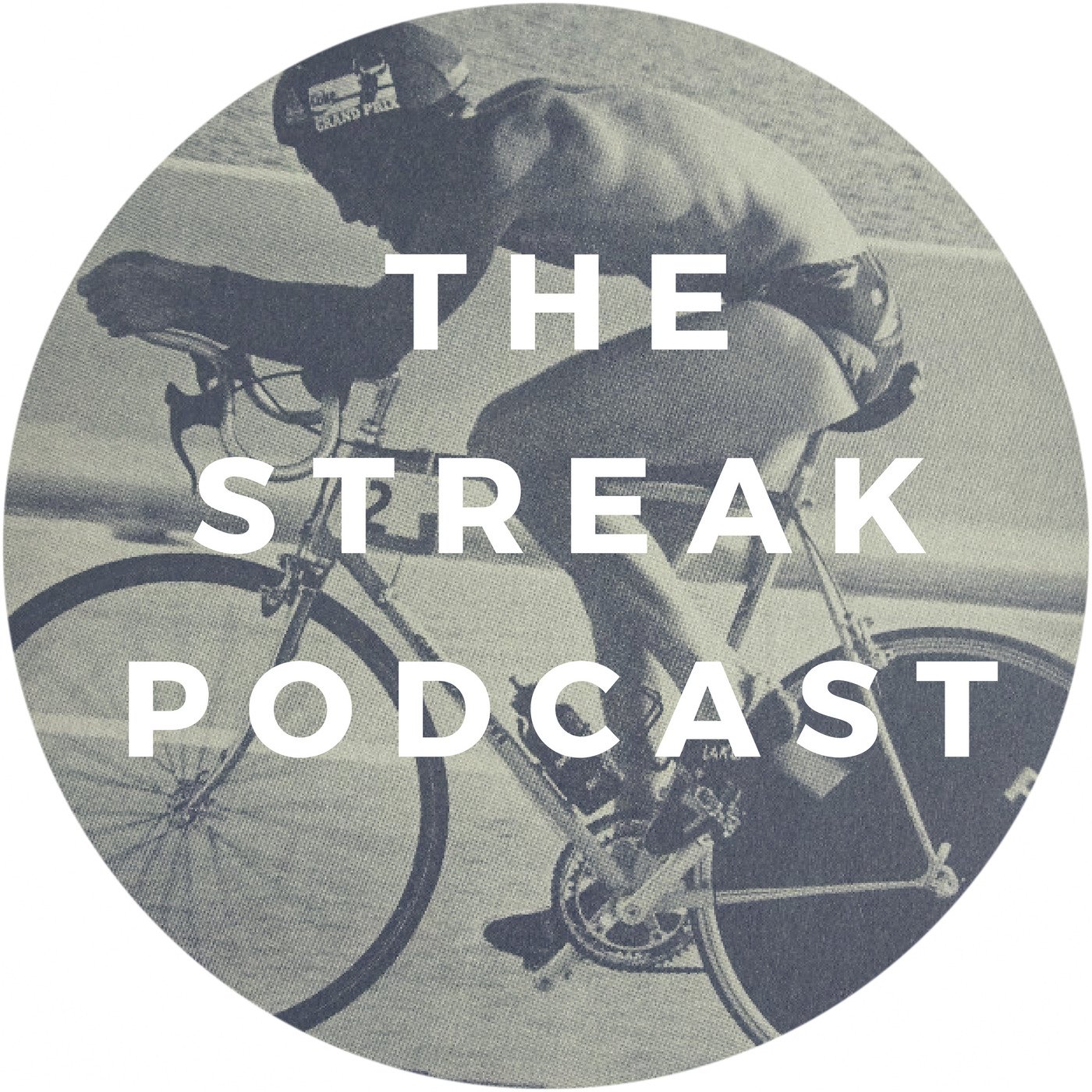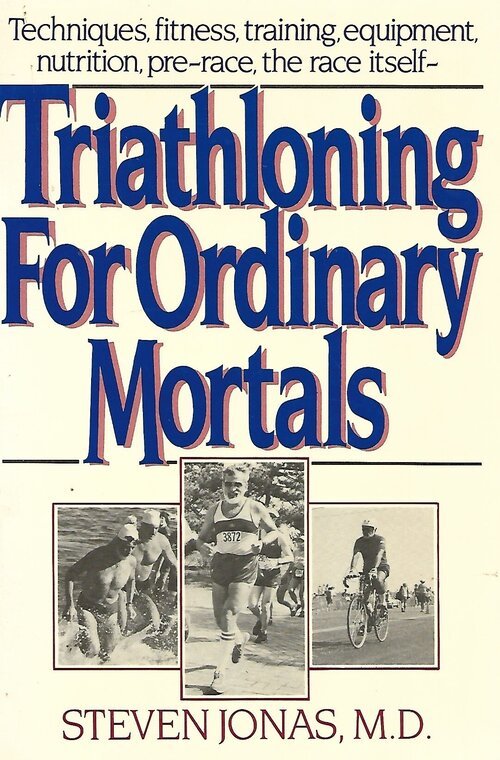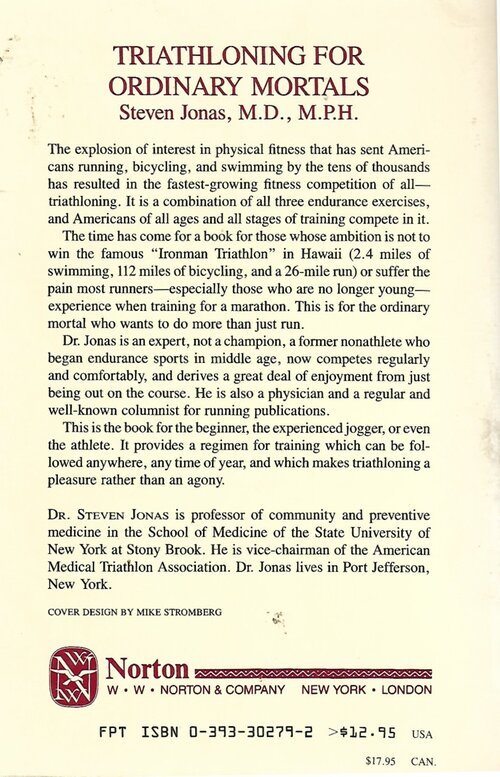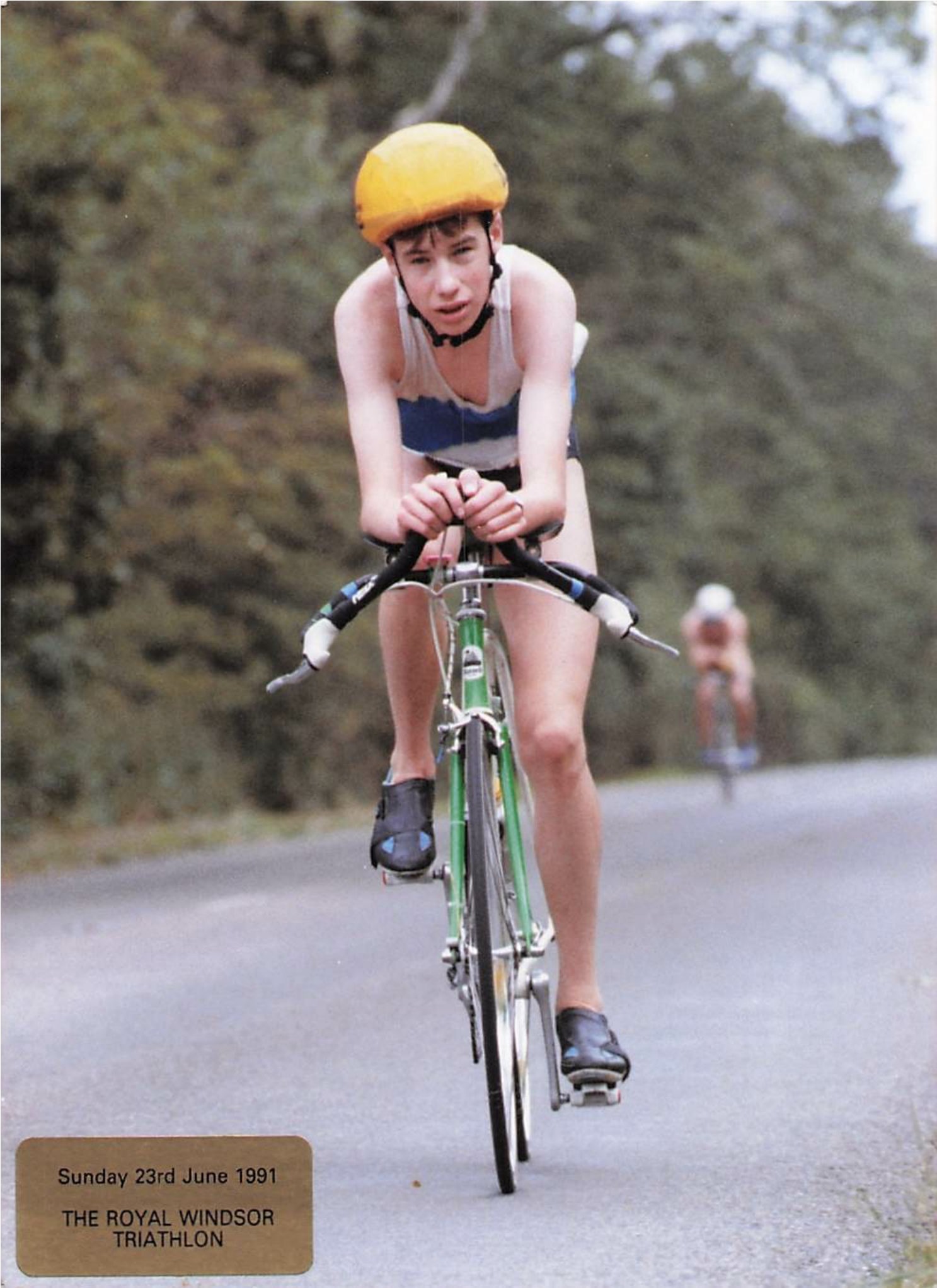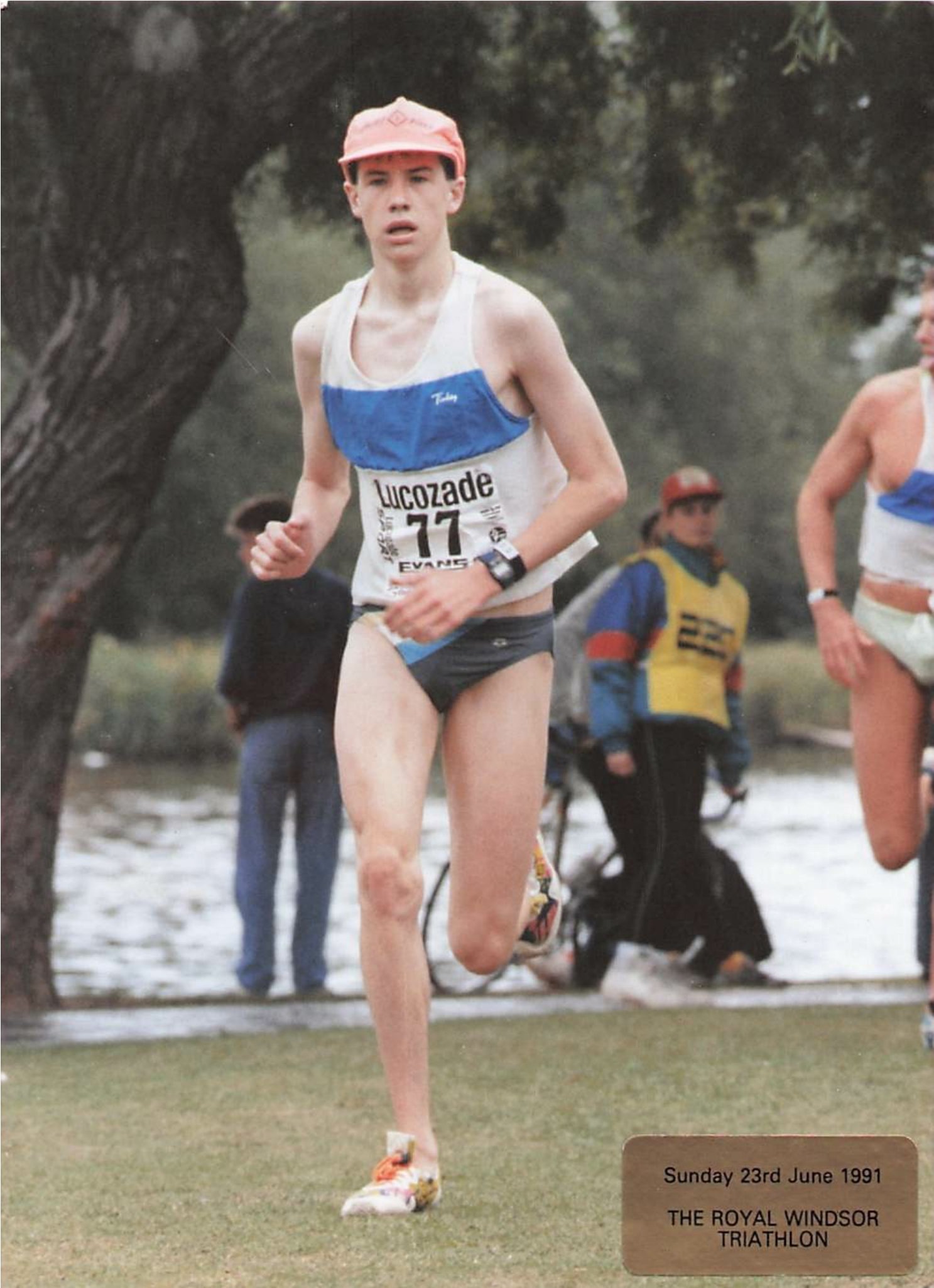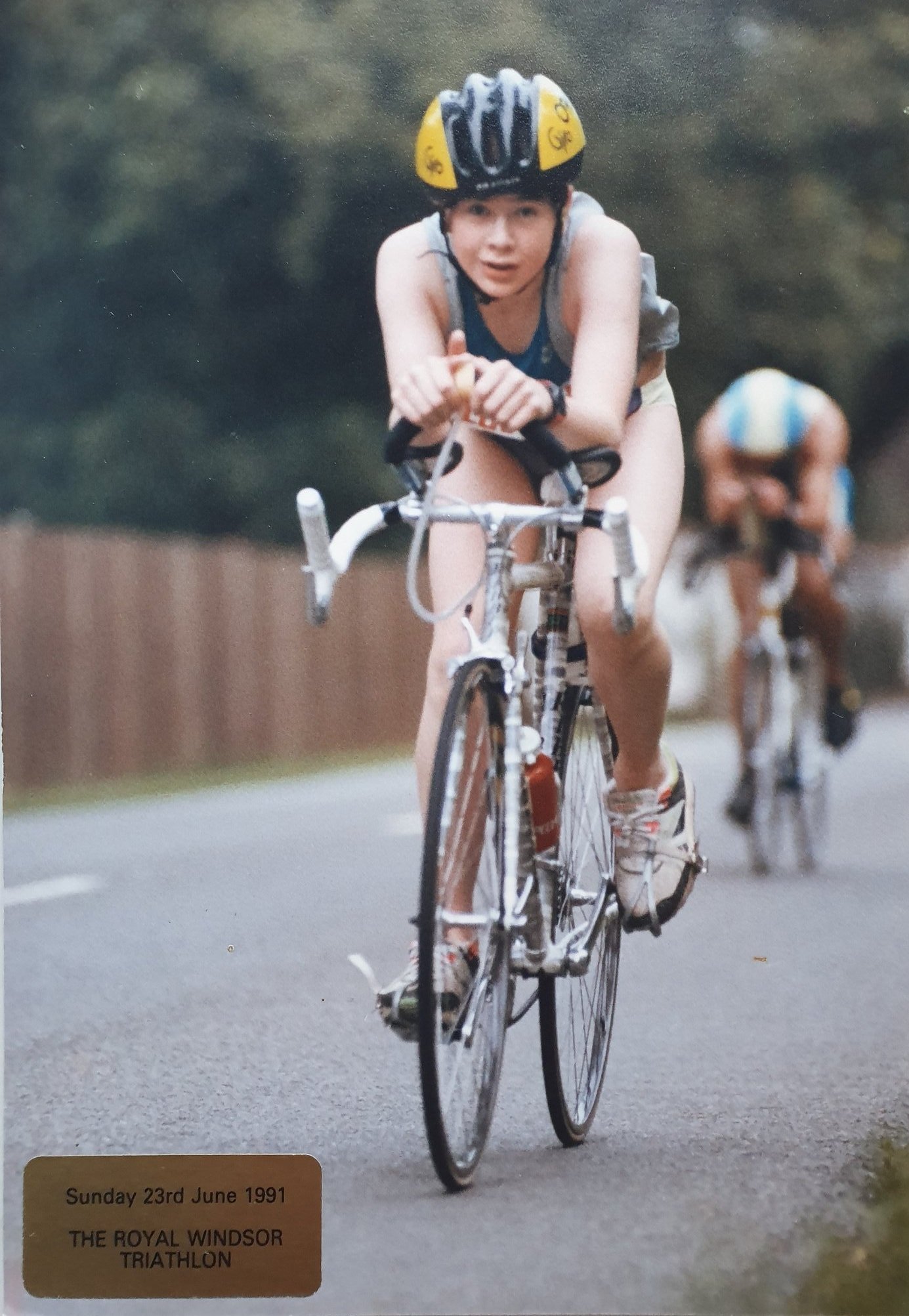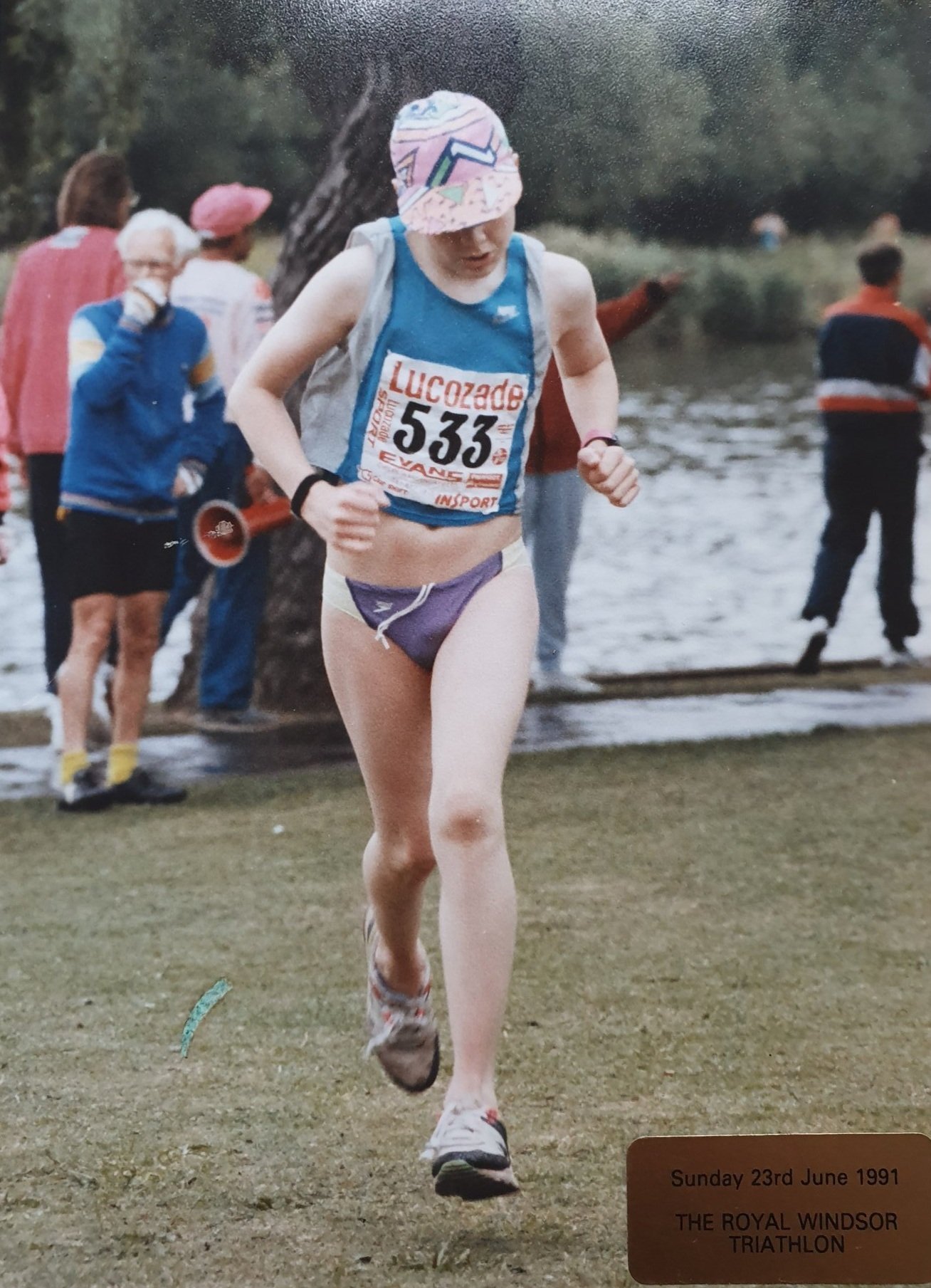France Diaries 3: Eyeshades!
I’ve never been into sunglasses. But I need to get some before my eyes get even worse. Actually I had an eye test in April. My eyes are fine. But I now need reading glasses in the evening or in low light.
But. In TSP13 I mentioned that athlete 703 on one of the postcards was maybe wearing Oakley Factory Pilot sunglasses.
A keen listener, Doug, picked me up on my use of the word sunglasses. He was right. Oakley stated in their magazine ads that sunglasses were good for nightclubs and press conferences. But for triathlon you need Eyeshades. France Diaries 3 has some more history.
France Diaries 2: The Absolute Must For Triathletes
France Diaries 2. Short podcasts from my holiday. I’m still at La Plage du Gurp. On the Atlantic coast. About an hour north of Bordeaux. Today we are looking at a kit flat-lay from 1988.
Triathlete Magazine used to do a lot of these. Mainly around Christmas time. With a variety of products and brands. But this one seems to be driven by the magazine’s own stuff, their spin-off Winning Club stuff or their main advertisers products.
I’ve posted the German version. But I also used to have it in English. Now listen to me explain what we have.
France Diaries 1: Ron Hill Club Special Vests
I’m on holiday in France.
So I’m going to record as many very short podcast episodes as I can. As I've been inspired recently by listening to the Cycling Podcast and Escape Collective Tour de France dispatches.
I’m going to record everything while walking. I don't want to be that guy sitting around the accommodation trying to shush people because I’m recording my very important podcast.
Today I’m at La Plage du Gurp. About an hour north of Bordeaux. And I’m talking about Ron Hill Club Special Vests.
Images:
Athletics Weekly (UK) 16th October 1982
Ross at the 1991 Tallington Lakes Triathlon
My Current Ron Hill Vest
Triathlete (FR) 1989 Avignon Special Issue
220 (UK) January 1990
220 (UK) October 1990
220 (UK) February 1990
220 (UK) April 1990
BTS 1991-1993 Ron Hill Vest
Luke’s Ron Hill “Glenn Cook” Vest
Links:
The Cycling Podcast
Escape Collective
BBC Sports Report by Pat Murphy
The Slough Demos Part One: A Triathlon History Tour
TSP7 & TSP8
Ron Hill at the 1962 Polytechnic Marathon
The Tour of Thamside
The Sun Life Great Race
Luke’s BTS Vests On Instagram
Sources:
Ron Hill on Wikipedia (FR)
Ron Hill on Wikipedia (EN)
Ron Hill Obituary In The Guardian
Ron Hill Sports History
Bonus: A Short Trip To Roth
In this bonus recording you’ll hear about a short bike trip that I took to Roth in August 2022. I was there to trace the history of the Challenge Roth Triathlon.
I’ve also included tips if you’re planning your own Roth racing and spectating weekend. And we look closely at the 1988 race. The best ever edition. IMO.
Images:
Tri-Athlete (FR) Septembre 1988
Tri-Athlete (UK) Oct-Nov 1988
Links:
Ross’s 2024 Rothsee Video
Ross’s 2024 Roth Video
1987 Avignon Triathlon Blog Post
Rothsee Triathlon
SV Heuberg Camping Spot
Roth Friday Night Sprint Triathlon
1984 Almere Triathlon Blog Post
1988 Roth Triathlon Video
TSP23: The 1983 Los Angeles Ricoh Ironman
Four Friends Trailer
Four Friends - Full Movie
TSP3: I Bought 4 Sets Of Scott DH handlebars
Luke’s Bike On GTN
Sources:
1984 Franken Triathlon in Roth
1987 Roth Report and Results
Rothsee Triathlon on Wikipedia
1987 Les Mureaux Triathlon in Tri-Athlete (FR) Juin 1987
Scott Tinley at Roth in Tri-Athlete (FR) Septembre 1986
1987 Roth Report in Tri-Athlete (FR) Aout 1987
Four Friends on Wikipedia
Rodekro Race Report in Tri-Athlete (UK) Sept-Oct 1989
1989 Roth report in Tri-Athlete (FR) Aout 1989
Some German Triathlon History
Challenge Roth on Wikipedia
TSP26: The 1990 Nice Triathlon
Today we are watching the 1990 Nice Triathlon video that’s on YouTube. It was probably the first Nice race that Luke and I saw. IMO. It’s the best English-language triathlon video on YouTube.
The scripted commentary by Sarah Springman and Ian Sweet is ace. And some big athletes were coming off great 1989 seasons. Of course. There’s our usual tangents into iconic equipment and previous races.
Images:
Triathlete (USA) October 1990
220 (UK) August 1990
Tri-Athlete (FR) Juillet 1990
Links:
1990 Nice Triathlon On YouTube
Running Hard by Steve Chilton
TSP14: The 1992 Nice Triathlon
TSP13: Tri-Athlete Magazine Postcards
1988 Triple Crown Blog Post
Mark Allen’s Total Triathlete
Seat Shifter Blog Post
J-Disc Blog Post
Sources:
Triathlete (USA) January 1989
Triathlete (USA) October 1989
Tri-Athlete (FR) Octobre 1987
Iron Will by Mike Plant
Triathlete (USA) May 1990
Tri-Athlete (FR) June 1990
Triathlete (USA) August 1990
Triathlete (USA) Sept 1990
Tri-Athlete (FR) Oct-Nov 1990
Triathlete (US) 1990 Hawaii Ironman Special Issue
220 (UK) August 1992
1987 Nice Triathlon on YT
1988 Nice Triathlon on YT
1989 Nice Triathlon on YT
Wild Wild Country Trailer on YT
Bonus: ESPN Running & Racing
In August 1989. On a family, sports and shopping holiday to Florida. I watched an episode of ESPN’s Running & Racing. A magazine show that covered running, cycling and triathlon.
I’ve recently found one episode on YouTube. Also from 1989. But it’s not the one that I saw in Florida. But let’s analyse it and talk a bit more about that Florida trip.
Image:
Triathlete (USA) August 1989
Links:
Tampa and the Nike Vest
ESPN Running and Racing (2nd July 1989)
Salmini Films YouTube Channel
Bonus: The Sweat Shop In Teddington
In 1971, Chris Brasher, Olympic Gold medallist, 4 minute mile pacer and future co-founder of the London Marathon, was heavily involved in the developing sport of orienteering. Realising that British orienteers were finding it hard to get hold of the specialist equipment. Like off-road running shoes and compasses. Chris started sourcing, importing and selling the stuff out of his car boot at events. This is the birth of The Sweat Shop.
Later in the 1970s a brick and mortar store was established in Teddington. And other forms of running were catered for. Not just orienteering. The shop I started visiting in the mid-1980s was at 10 The Causeway, Teddington. In 1987 they moved into larger premises just 200m away at 33 Broad Street.
As a teenage runner, a trip to The Sweat Shop was always a special day out. With pocket, birthday and Christmas money saved up. And short and long lists of possible purchases carefully curated.
Join me the day before the 2025 London Marathon to learn more about The Sweatshop. With relevant and random tangents into my history with the shop and the London Marathon.
Images:
1980s Sweat Shop Advertisements
Links:
1982 London Marathon
1983 London Marathon
1984 London Marathon
1985 London Marathon
The first ever 4 MINUTE MILE: BBC Archive
The Perfect Mile by Neal Bascomb
3:59.4 by John Bryant
The Four Minute Mile (1988) TV series
Chris Brasher - The Man Who Made The London Marathon by John Bryant
John Disley - Running After Dad
The London Marathon: The History of the Greatest Race on Earth by John Bryant
The Guinness Book of The Marathon
https://teddingtontown.co.uk/sweatshop/
Sources:
Saint and Greavsie
The Observer
NYC Marathon History
Sweatshop - We Know Running
London Marathon TV - John Bryant
TSP24: Season Openers Part 1
This episode is Part 1 of a two-parter about Season Openers. The traditional races in the late-1980s that let us know that the tri-season had started. Both domestically and internationally.
The idea came from recently leafing through two triathlon magazines that had significance to my life. That brought back waves of nostalgia from the time when I first got interested in triathlon.
These season opener races were important for the athletes. To validate their fitness after a winter of training. But for the magazine readers. These race reports were all we had. Before Eurosport or live streams or YouTube.
This is how we got to understand the racing and to learn about the athletes. In articles written by familiar names like CJ Olivares Junior, Chip Rimmer, Richard Graham or Terry Mulgannon.
There’d be backstory, play by play race commentary, athlete profiles and a discussion of what the results meant. Therefore building up a season-long narrative to follow along with.
We’d find out if the Big 4 and Mike Pigg were still at the top. And who were the up and coming athletes? As nobody was vlogging or uploading their breakfast to instagram.
And via the excellent photography that accompanied the articles we also got to see the new bikes and kit.
So have a listen. And learn more about the 1988 Lanzarote Triathlon, the Gold Coast World Cup and the Swindon Triathlon in the UK.
Images:
Triathlete (UK) July 1988
Links:
TSP21: My First Wetsuit. My Favourite Wetsuit. One I’d Like To Get Hold Of. And Some History.
TSP4: The Le Coq Sportif Grand Prix
TSP20: The 1991 St. Croix Triathlon
TSP16: The 220 Triathlon Series - Year 1
Ross’s Swindon 1990 Blog Post
Luke’s Tampa Blog Post
Emily Post Etiquette
Sources:
Cotswold Lakes
220 (UK) June 1992
220 (UK) June 1994
220 (UK) June 1995
TSP23: The 1983 Los Angeles Ricoh Ironman
In 1988 Valerie Silk and her Ironman company added two more franchise races to their roster. Ironman Europe in Roth. And Ironman Australia in Forster-Tuncurry. That brought the total number to six. With Hawaii, Canada, Japan and New Zealand.
However, the first Silk-sanctioned race outside of Hawaii had already come and gone. It was the Ricoh Los Angeles Ironman. In 1983. In this episode we’ll dive into that race. And go over some vital Hawaii Ironman backstory. That sets up a few more episodes about the race.
Images:
Runner’s World (USA) December 1980
Triathlon (USA) Fall 1983
Links:
IRONMAN by Freewheelin’ Films. With Bruce Dern.
Runner’s World (USA) December 1980
Wide World Of Sports Intro
Tri-Athlete (FR) Juillet 1985 - 1985 Ironman NZ Race Report.
Tri-Athlete (USA) January 1987 - 1986 Ironman Canada Race Report.
Tri-Athlete (FR) Septembre 1988 - 1988 Ironman Europe Race Report
Tri-Athlete (UK) Oct / Nov 1988 - 1988 Ironman Europe Race Report
1986 Ironman Canada on YT
1988 Ironman Europe on YT
Triathlete (USA) August 1990 - Gills and Voth.
ABC coverage of the February 1982 Hawaii Ironman
Early wetsuits on TSP21
Skid Lid helmets by Old Triathlon Stuff
Bell V1 Pro by Old Triathlon Stuff
Sources:
Triathlon: A Personal History by Scott Tinley
Triathlete (USA) 1990 Hawaiian Ironman Special Issue
Ironman New Zealand History
Ironman Japan History
Ironman Canada History
Ironman Australia History
Ironman Europe History
Wide World of Sports
The Slough Demos Part 1: A Triathlon History Tour
This is the first in a series of episodes called The Slough Demos. Mainly about what it was like growing up in Slough in the 1980s as a teenage triathlon nerd.
TSP2: The Speed And The Sweat was about the first triathlon I ever did. In May 1989 in Wokingham. And these episodes will follow on from that. With some prequel stuff too. Part 1 is a running tour of Slough that you can do to get an overview of the triathlon history that exists there.
The inspiration for this episode came from a YouTube video on the Ginger Runner channel. It’s with Ben Gibbard from the band Death Cab For Cutie. And he describes a 46 mile run he did through Seattle visiting famous local music landmarks.
Enjoying learning more about Slough!
Images:
Tri-Athlete (UK) Nov-Dec 1987
220 (UK) October 1990
220 (UK) November 1990
Tri-Athlete (UK) July 1988
Tri-Athlete (UK) October-November 1988
Triathlete (UK) August 1990
220 (UK) December 1989
Tri-Athlete (UK) Nov-Dec 1987
British Triathlon Scene (UK) Dec 1989-Jan 1990
British Triathlon Scene (UK) November 1989
Tri-Athlete (UK) July 1987
1988 Raleigh Catalogue
Triathlete (USA) May 1987
Tri-Athlete (UK) September 1988
Me finishing the 1991 Windsor Triathlon
My Dave Russell. Maybe taken in the Autumn of 1990
Links:
Slough by David Brent
TSP2: The Speed And The Sweat
Slough Trading Estate History
Slough Trading Estate Video
Slough Community Centre History
Ginger Runner with Ben Gibbard
USTS Hilton Head 1987
TSP9: The First British Triathlon Shown On TV
TSP21: My First Wetsuit. My Favourite Wetsuit. One I’d Like To Get Hold Of.
And Some History.
TSP16: The 220 Triathlon Series - Year 1
1989 Avignon Triathlon
Dave Russell on Classic Lightweights
TSP3: I Bought 4 Sets of Scott DH Handlebars
220 (UK) July 1995
Sources:
Slough on Wikipedia
Mars Inc on Wikipedia
Slough History Online
220 (UK) September 1989
British Triathlon Scene (UK) June 1989
220 (UK) October 1991
220 (UK) March 1989
Stows Cycles History Page
Cinnamon Cafe History Page
Windsor Leisure Centre History
Dorney Lake
TSP22: The 1993 Bordeaux Indoor Triathlon
In this episode Luke and I do another 1980s or 1990s race watch-along. This is our 3rd one. Check out TSP14: The 1992 Nice Triathlon and TSP20: The 1991 St. Croix. Triathlon. To listen to the two previous races that we covered in incredible, maybe too much, detail.
Today we are looking at the 1993 Bordeaux Indoor Triathlon. An event that TED magazine called. A turning point for the sport. A day as historical as the first Hawaii Ironman or first Nice triathlon. Knowing what we know now I don’t quite agree with this. The format did go somewhere. But not far.
So let’s find out more about those 2 days in February 1993.
Images
220 (UK) April 1993
Triathlete (FR) Jan-Fev 1993
Triathlete (FR) Avril 1993
TED (FR) Jan-Fev 1993
TED (FR) Avril 1993
TED (FR) Mars 1993
Links
1993 Bordeaux Indoor Triathlon on YT
TSP14: The 1992 Nice Triathlon
TSP20: The 1991 St Croix Triathlon
TSP8: 1994 France Iron Tour
1994 Paris Indoor Triathlon on YT
220 (UK) May 1994. Paris-Bercy Indoor Triathlon Report.
Triathlete (FR) Avril 1994. Paris-Bercy Indoor Triathlon Report.
220 (UK) April 1995. Perth Indoor Triathlon Report.
2024 World Triathlon Indoor Cup Lievin
1989 Avignon Worlds
Other Sources
220 (UK) Dec 1993-Jan 1994. Indoorman Dortmund.
LA Times 1990 McCarthy Article
2009 Colorado Daily McCarthy Article
Triathlete (UK) August 1990
1990 Worlds
TSP21: My First Wetsuit. My Favourite Wetsuit. One I’d Like To Get Hold Of. And Some History.
I’m back on the mic for TSP21. It’s all about wetsuits. I tell you about my first triathlon wetsuit. That I bought from total Fitness in Swindon at the end of 1989. And go over my favourite wetsuit ever.
There’s also plenty of triathlon history. Including a 1986 international wetsuit kerfuffle story. Based in Milton Keynes. And you'll find out which 1980's wetsuit I like to find on eBay one day.
Images:
Tri-Athlete (UK) May 1988
Tri-Athlete (UK) May 1987
Ross at the 1990 Swindon Triathlon
220 (UK) March 1989
220 (UK) April 1989
220 (UK) August 1989
220 (UK) November 1989
220 (UK) January 1990
220 (UK) April 1990
Tri-Athlete (UK) March - April 1988
Tri-Athlete (FR) Juillet 1987
Tri-Athlete (UK) August 1988
220 (UK) March 1990
Tri-Athlete (FR) Juin 1986
Tri-Athlete (FR) Juin 1987
Tri-Athlete (UK) July 1988
Tri-Athlete (FR) May 1987
220 (UK) August 1991
Ross at 1996 Dole Triathlon
Triathlete (USA) April 1987
Links:
TSP16: The 220 Triathlon Series - Year 1
TSP3: I Bought 4 Sets Of Scott DH Handlebars
1986 Milton Keynes Report
1985 Nice Triathlon
1986 Nice Triathlon
1987 USTS Baltimore Triathlon
Danny Boy And The Rubber Suit Brigade
TSP20: The 1991 St. Croix Triathlon
Sources:
220 (UK) November 1992
Tri-Athlete (UK) August 1988
Tri-Athlete (UK) May 1988
Tri-Athlete (FR) 1985 et 1986
Aquaman History
Tri-Athlete (UK) July 1987
Tri-Athlete (UK) February 1987
TSP20: The 1991 St. Croix Triathlon
We’re back with Season 2. I’m hoping to do more and better in 2024. Maybe aiming for one episode every fortnight.
I’m also reunited with my most popular guest slash co-host. According to the Buzzsprout statistics at least. My brother Luke.
The event we are focusing on today is the 1991 St Croix Triathlon.
Starting in 1988 St. Croix was one of a few early season races where a lot of the best athletes showed up. And in 1991 the event was the first ever stop on the new ITU World Series.
Images:
220 (UK) January 1991
220 (UK) June 1991
Triathlete (USA) August 1991
Triathlete (FR) Juin 1991
Links:
TSP14
1991 St Croix Triathlon on YouTube
Triathlete (USA) July 1988. 1988 St.Croix Triathlon race report.
Tri-Athlete (FR) Juin 1988. 1988 St.Croix Triathlon race report.
Tri-Athlete (UK) June 1988. 1988 St.Croix Triathlon race report.
Triathlete (USA) August 1989. 1989 St.Croix Triathlon race report.
Tri-Athlete (FR) June 1989. 1989 St.Croix Triathlon race report.
220 (UK) June 1989. 1989 St.Croix Triathlon race report.
Celebrating 20 Years Of ITU World Cup History
20 Years Of ITU World Cups With Mike Pigg
German Wikipedia: St. Croix Triathlon
1991 Texas Hill Country Triathlon
Ross’s J-Disc Blog Post
Sources:
Triathlete (USA)January 1988
Triathlete (USA) March 1990
220 (UK) February 1991
220 (UK) March-April 1991
220 (UK) April 1993
220 (UK) March-April 1994
TSP19: Books To Start Your Triathlon History Journey
I think all modern triathletes should be reading about our sport’s past. Especially the eighties stuff. To understand the history of the game. And decide where we should take it. So today I’m talking about twelve triathlon books to get you started on your triathlon history journey.
Some of the books are modern look-backs and some are books from the early days of the sport that give you a cool feel for the era. Decide what you’re more into and go and get hold of some. Here we go. In no particular order of favouritism or period.
Links:
The Amateurs by David Halberstam
Assault on Lake Casitas by Brad-Alan Lewis
True Blue by Dan Topolski with Patrick Robinson
A Good Walk Spoiled by John Feinstein
The Green Road Home by Michael Bamberger
The Greatest Game Ever Played by Mark Frost
Brad Kearns
Competitor Magazine
TSP6: The Timey Ironman Watch
TSP18: My 1980s Tri Bike
Over the last 18 months I’ve been putting together a 1980s tri bike. It was a fun project. I particularly enjoyed sourcing the bits and learning more about the groupsets of the day.
This episode is about what I like about the bikes from this period. The inspiration for the project. And the component choices I made.
TSP17 : Some Munich Triathlon History
In TSP16 I did a bit of triathlon history from near where I grew up in the UK. And today’s podcast is about some triathlon history from my current hometown. Munich in Germany.
Our story is based at the Regattastrecke in Oberschleißheim. The facility was built for the rowing and flat water canoeing events at the 1972 Olympic Games. And it’s still in use for those sports today.
It’s a super place to visit for some Olympic history. The boat sheds and grandstands at the Regattastrecke really look like they are stuck in 1972.
However the tarmac on the rectangular nearly 5km circuit around the lake was brand new in the spring of 2023. This makes the venue an ideal and popular venue for local triathlons. I’ve done quite a few events here.
But probably the best field ever assembled here was for a round of the European Golden Cup Circuit on the 23rd July 1989. In this episode we’ll learn what happened on the day nearly 34 years ago.
TSP16: The 220 Triathlon Series - Year 1
In 1991 the team at 220 launched a 5 race triathlon series. It would last 5 years. Add a new narrative to the British triathlon season. And provide plenty of content to fill the pages of the magazine.
One of the races on the docket was Windsor. As teenage tri-nerds, the Windsor Triathlon was a big deal for me and my brother. Because it brought a big race and top athletes to within 5km of our house.
In this episode find out more about the first year of the 220 Triathlon Series and what the Windsor race was like back then.
Images:
220 (UK) February 1991
220 (UK) January 1991
220 (UK) July 1991
220 (UK) August 1991
220 (UK) October 1991
220 (UK) September 1991
220 (UK) November / December 1991
Links:
TSP4: The Le Coq Sportif Grand Prix
1991 Ironbridge Marathon Triathlon
USTS Entry Forms in 1984 and 1985
Swindon 1990
Evans - Cannondale
TSP9: The First British Triathlon Shown On TV
TSP14: The 1992 Nice Triathlon
John Lillie’s Blog. Early 220.
1991 Hawaii Ironman Results
Sources:
The Windsor Tapes
I'm writing a podcast about the first year of the 220 Triathlon Series. It took place in the UK in 1991. I'll put the full episode out next Friday.
But here’s some raw audio I recorded with Luke when we recreated the 1991 Windsor Triathlon. That was the 2nd race in the 220 Series. After Swindon.
The Windsor Triathlon was a big deal for us as teneage tri-nerds. Because it brought a big race and top athletes to within 5km of our house.
And the 220 series brought a new narrative and professionalism to the British triathlon calendar. After the GP ended in 1989.
Leave a comment below if you were there!
TSP15: The 1986 Triathlon International de Paris
A couple of weeks ago I was pretty psyched to see what happened at the Olympic Test Event in Paris. Yet. Triathloning isn’t new to downtown Paris. The first Triathlon International de Paris took place on 13th September 1986.
And the Triathlon Hauts de Seine on the Ile de Puteaux was earlier in the 1986 season. There were also ITU World Cup races in 1991 and 1996. And a few French Grand Prix events. I’ll cover all of those triathlons in the future.
Today. Let’s look at what happened at the first Triathlon International de Paris. Before covering those other races in future episodes.
Images:
Tri-Athlete (FR) Octobre 1986
Triathlete (USA) February 1987
Links:
Triathlon: The Sporting Trinity by Aleck Hunter and Erik Kirschbaum
1986 Triathlon International de Paris Press Pack
Sources:
Tri-Athlete (FR) Mai 1987
Tri-Athlete (FR) Juin 1985
Tri-Athlete (FR) Mai 1986
Tri-Athlete (FR) Juin 1986
Tri-Athlete (FR) July 1986
Tri-Athlete (FR) Septembre 1986
Tri-Athlete (FR) Juillet 1992
Triathlete (USA) February 1987
ITU Triathlon World Cup
TSP14: The 1992 Nice Triathlon
This episode is going to be the first of hopefully a three part series that will look at the Summer of 1992. 1992 was the first year that I raced in France on a family holiday. And from buying Triathlete magazines in French. Which I couldn't read at the time. I started to get interested in the triathlon scene over there.
The idea for this series comes from a video recently posted by Ben Bright. It’s a must-watch for anybody interested in triathlon history. Following Bright’s career in France from 1992 onwards was one of the inspirations for me to figure out how to move to France and find a French triathlon club to race for.
Today we are going to look at Nice, which took place on 14th June. Then Grenoble from the 28th June and Ironbridge which was organised on the 18th July. Ben Bright did all three. So the logical conclusion to the series would be to try and contact him to ask if he would agree to come on the podcast. To take us through those 5 crazy weeks in 1992.
Images:
Triathlete (USA) October 1987
Triathlete (FR) Juillet 1992
220 (UK) August 1992
220 (UK) October 1992
Triathlete (FR) Hors Serie. The Best Of 1992.
Links:
1992 Triathlon de Nice
Nice Triathlon 1992 - Ben Bright
TSP10: Thinking Of France
Nice 1993
1995 Nice Triathlon
TSP5: UK Triathlon Magazines 1986-1990
The Epic History of triathlon in France, France by Mark Allen
Nice Videos: 1985. 1990. 1992. 1993. 1995.
Scott Tinley’s Winning Triathlon by Scott Tinley. With Mike Plant.
The Ultimate Pass: Nice 1992 by Mark Allen
TED (FR) Octobre 1993
Sources:
TED (FR) Août-Septembre 1992
220 (UK) September 1992
Triathlon: The Sporting Trinity by Aleck Hunter and Erik Kirschbaum
Tri-Athlete (FR) Octobre 1987
Triathlon International de Nice on Wikipedia
Tri-Athlete (UK) Nov-Dec 1987
Triathlete (FR) Aout 1992

